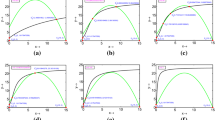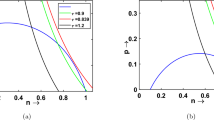Abstract
Cooperative hunting is a widespread phenomenon in the predator population which promotes the predation and the coexistence of the prey-predator system. On the other hand, the Allee effect among prey may drive the system to instability. In this work, we consider a prey-predator model with Type-III functional response involving the hunting cooperation in predator and Allee effect in the growth rate of the prey population. Here our aim mainly is to demonstrate the impact of both the Allee effect and hunting cooperation on the system dynamics. Mathematically our analysis primarily focuses on the stability of coexisting equilibrium points and all possible bifurcations that the system may exhibit. We have observed transcritical bifurcation, saddle-node bifurcation, Hopf-bifurcation, Bogdanov-Takens bifurcation and SN-TC bifurcation point respectively in the course of studying the global dynamics.





Similar content being viewed by others
References
Kashif, A.S., Peet, A.B., Peacock-Lopez, E.: Complex dynamics in a modified macarthur–rosenzweig model with predator paring. J. Biol. Syst. 20(01), 87–108 (2012)
Alves, M.T., Hilker, F.M.: Hunting cooperation and Allee effects in predators. J. Theor. Biol. 419, 13–22 (2017)
Banerjee, Swarnendu, Sha, Amar, Chattopadhyay, Joydev: Cooperative predation on mutualistic prey communities. J. Theor. Biol. 490, 110156 (2020)
Berec, Luděk: Impacts of foraging facilitation among predators on predator-prey dynamics. Bull. Math. Biol. 72(1), 94–121 (2010)
Berec, Luděk, Angulo, Elena, Courchamp, Franck: Multiple allee effects and population management. Trends Ecol. & Evol. 22(4), 185–191 (2007)
Cosner, C., DeAngelis, D.L., Ault, J.S., Olson, D.B.: Effects of spatial grouping on the functional response of predators. Theor. Popul. Biol. 56(1), 65–75 (1999)
Dennis, Brian: Allee effects: population growth, critical density, and the chance of extinction. Nat. Resour. Model. 3(4), 481–538 (1989)
Donohue, J.G., Piiroinen, P.T.: Normal-form analysis of the cusp-transcritical interaction: applications in population dynamics. Nonlinear Dyn. 100, 1–13 (2020)
Freedman, H.I.: Deterministic Mathematical Models in Population Ecology, vol. 57. Marcel Dekker Incorporated, New York (1980)
Hastings, A.: Population Biology: Concepts and Models. Springer Science & Business Media, Berlin (2013)
Hsu, Sze-Bi: On global stability of a predator-prey system. Math. Biosci. 39(1–2), 1–10 (1978)
Jang, S.R.J., Zhang, W., Larriva, V.: Cooperative hunting in a predator-prey system with allee effects in the prey. Nat. Resour. Model. 31(4), e12194 (2018)
Kot, Mark: Elements of Mathematical Ecology. Cambridge University Press, Cambridge (2001)
Kuang, Yang, Freedman, H.I.: Uniqueness of limit cycles in gause-type models of predator-prey systems. Math. Biosci. 88(1), 67–84 (1988)
Lotka, J.: A natural population norm. i. J. Wash. Acad. Sci. 3(9), 241–248 (1913)
Pal, Saheb, Pal, Nikhil, Chattopadhyay, Joydev: Hunting cooperation in a discrete-time predator-prey system. Int. J. Bifurc. Chaos 28(07), 1850083 (2018)
Pal, Saheb, Pal, Nikhil, Samanta, Sudip, Chattopadhyay, Joydev: Effect of hunting cooperation and fear in a predator-prey model. Ecol. Complex. 39, 100770 (2019)
Pal, Saheb, Pal, Nikhil, Samanta, Sudip, Chattopadhyay, Joydev: Fear effect in prey and hunting cooperation among predators in a leslie-gower model. Math. Biosci. Eng 16(5), 5146–5179 (2019)
Perko, L.: Differential Equations and Dynamical Systems. Springer Science & Business Media, Berlin (2013)
Přibylová, Lenka, Berec, Luděk: Predator interference and stability of predator-prey dynamics. J. Math. Biol. 71(2), 301–323 (2015)
Rocha, J.L., Fournier-Prunaret, D., Abdel-Kaddous, T.: Strong and weak allee effects and chaotic dynamics in richards’ growths. Discret. Contin. Dyn. Syst.-B 18(9), 2397 (2013)
Ryu, Kimun, Ko, Wonlyul: Asymptotic behavior of positive solutions to a predator-prey elliptic system with strong hunting cooperation in predators. Phys. A: Stat. Mech. Appl 531, 121726 (2019)
Saputra, K.V.I., Veen, L.V., Quispel, G.R.W.: The saddle-node-transcritical bifurcation in a population model with constant rate harvesting. Discrete Contin. Dyn. Syst. Ser. B 14(01), 233–250 (2010)
Sen, D., Ghorai, S., Banerjee, M.: Allee effect in prey versus hunting cooperation on predator-enhancement of stable coexistence. Int. J. Bifur. Chaos 29(06), 1950081 (2019)
Sen, Moitri, Banerjee, Malay, Morozov, Andrew: Bifurcation analysis of a ratio-dependent prey-predator model with the allee effect. Ecol. Complex. 11, 12–27 (2012)
Sotomayor, Jorge.: Generic bifurcations of dynamical systems. In Dynamical systems, pages 561–582. Elsevier (1973)
Stephens, P.A., Sutherland, W.J.: Consequences of the allee effect for behaviour, ecology and conservation. Trends Ecol. & Evol. 14(10), 401–405 (1999)
Terry, A.J.: Predator-prey models with component allee effect for predator reproduction. J. Math. Biol. 71(6–7), 1325–1352 (2015)
Turchin, Peter: Complex Population Dynamics: A Theoretical/Empirical Synthesis, vol. 35. Princeton University Press, New Jersey (2003)
Volterra, V.: Fluctuations in the abundance of a species considered mathematically. Nature Publishing Group, Berlin (1926)
Warder Clyde Allee: Animal aggregations: a study in general sociology. The University of Chicago Press (1931)
Zhang, Jun, Zhang, Weinian: Dynamics of a predator-prey model with hunting cooperation and allee effects in predators. Int. J. Bifur. Chaos 30(14), 2050199 (2020)
Acknowledgements
The work of Krishnanand Vishwakarma is supported by research fellowship from Ministry of Human Resource Development (MHRD), Government of India [F.No.17-2/2014 TS-1]. The work of Dr. Moitri Sen is partially funded by the MATRICS project with ref. no. MTR/2018/001283 of SERB, Govt. of India.
Author information
Authors and Affiliations
Corresponding author
Additional information
Publisher's Note
Springer Nature remains neutral with regard to jurisdictional claims in published maps and institutional affiliations.
Appendices
Appendix A1.
corresponding to the bifurcation diagram given in Fig. 2
Phase portrait diagrams corresponding to Fig.(2) in different region from \({R_1\rightarrow R_7}\) respectively with the fixed parameter values are \(\beta =0.2, \eta =1, h=0.5\) for the various choice of \(\sigma \) and \(\alpha \) is a\(\sigma =1.1, \alpha =5.0\),b \(\sigma =0.716, \alpha =6.23\), c \(\sigma =0.57, \alpha =2.38\), d \(\sigma =0.75, \alpha =9.44\), e \(\sigma =0.72, \alpha =16.91\), f \(\sigma =0.56, \alpha =14.18\), g \(\sigma =0.02, \alpha =8.48\)
Appendix A2.
corresponding to the bifurcation diagram given in Fig. 3
Phase portrait diagrams corresponding to Fig.(3) in different region from \({R_1\rightarrow R_6}\) respectively with the fixed parameter values are \(\beta =-0.05, \eta =1, h=0.5\) for the various choice of \(\sigma \) and \(\alpha \) are a \(\sigma =0.80, \alpha =2.16\), b \(\sigma =0.719, \alpha =5.23\), c \(\sigma =0.544, \alpha =2.344\), d \(\sigma =0.76, \alpha =9.47\), e \(\sigma =0.74, \alpha =12.57\), f \(\sigma =0.587, \alpha =11.96\)
Rights and permissions
About this article
Cite this article
Vishwakarma, K., Sen, M. Influence of Allee effect in prey and hunting cooperation in predator with Holling type-III functional response. J. Appl. Math. Comput. 68, 249–269 (2022). https://doi.org/10.1007/s12190-021-01520-1
Received:
Revised:
Accepted:
Published:
Issue Date:
DOI: https://doi.org/10.1007/s12190-021-01520-1
Keywords
- Predator-prey model
- The Allee effect
- Hunting cooperation
- Functional response
- Stability analysis
- Bifurcation






